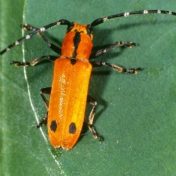Last week the Australian Pesticides and Veterinary Medicines Authority (APMVA) updated minor use permit PER88226 for the in-furrow application of fipronil to manage lucerne crown borer (Zygrita diva, LCB) in soybeans at planting. Changes include: Extension of expiry date to 30 September 2025 Addition of a re-entry statement and S161 statement Adjustments to the protection statement Moving spray drift to… Read more »
UPDATE: Crop progress report (March 2018) Recent photos of the crop where a stem fly infestation was reported in early February show signs of stem fly pupation, but no crop stress symptoms (i.e. no yellow and dying leaves), indicating that managing the outbreak when it was first detected would have been a waste of time and money (assuming there will… Read more »
Once again, lucerne crown borer (LCB) (Zygrita diva) has been active in soybeans this season. Worst affected regions were the Northern Rivers and the Liverpool Plains in NSW, but reports were also fielded from the Bundaberg, Fassifern and Darling Downs regions in Queensland. In some of the severely affected crops, over 80% of plants were infested, and up to 70%… Read more »
The 2013/14 soybean growing season has been challenging for many growers with very low rainfall and high temperatures until late March. Crop stress was sometimes wrongly attributed to insect pests although a number of crops were infested with more unusual pests such as etiella. The high temperatures also increased the impact of lucerne crown borer in infested crops.
An estimated 4,000 ha of soybeans near Casino in Northern NSW have been affected to varying degrees by soybean stem fly (Melanagromyza sojae) , a pest rarely seen in damaging numbers in Australia. Damage in many Casino crops is confounded by the presence of charcoal rot, a disease which blocks the plant’s vascular (xylem and phloem) tissue and causes similar… Read more »
Etiella (Etiella behrii) larvae have been observed in significant numbers (up to 10 larvae per square metre) in vegetative soybean crops in the Cecil Plains/ Pampas regions of the Darling Downs, and in low numbers (<1/sqm) in a DAFF soybean trial at Kingaroy. These infestations are likely due to the current hot and dry seasonal conditions which historically favour increased… Read more »
Every year we receive reports of white heads in wheat, and while there are several possible causes of this symptom, one suspect implicated in the crime is a small stem boring larva called Ephysteris silignitis (Turner) belonging to the moth Family Gelechiidae.


